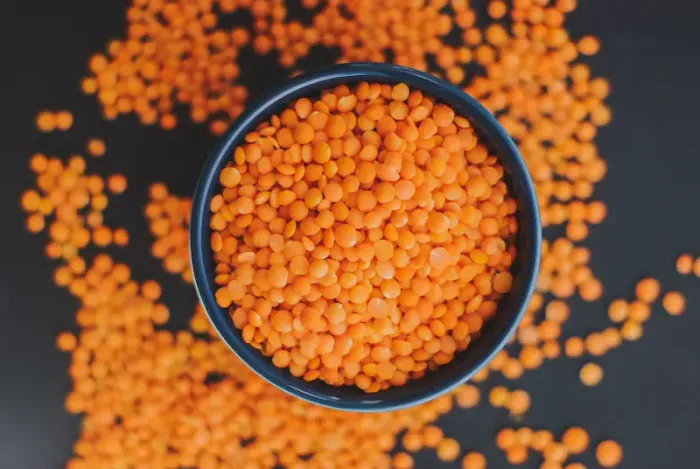Masoor Dal (Red Lentil): Ayurvedic Benefits, Nutrition, and Side Effects
Explore masoor dal benefits, lentil protein, and its place in an Ayurvedic diet. Get nutrition facts, cooking tips, and side effects from trusted sources.

Written by Dr. J T Hema Pratima
Reviewed by Dr. Shaik Abdul Kalam MD (Physician)
Last updated on 12th Nov, 2025

Introduction
Masoor dal (red lentil) is a pantry staple in many homes—and for good reason. It cooks quickly, tastes comforting, and packs impressive nutrition. If you’re curious about masoor dal benefits, how much lentil protein you actually get, and how this humble legume fits into an ayurvedic diet, you’re in the right place. Below, you’ll find clear, evidence-based guidance on nutrition and health, plus practical Ayurvedic-inspired tips, simple cooking ideas, and precautions to know.
What Is Masoor Dal? (Red Lentil)
• Masoor dal refers to red lentils. They are usually sold split and hulled, which is why they cook in 15–20 minutes without soaking.
• Flavor: mild, slightly sweet and earthy.
• Texture: soft and creamy when cooked—great for soups, dals, stews, and purees.
• Naturally gluten-free and budget-friendly.
Lentil Protein and Key Nutrition at a Glance
Red lentils are nutrient-dense. Exact values vary by brand and cooking method, but a typical 1/2 cup (about 100 g) cooked lentils provides approximately:
• Protein: ~9 g of plant-based protein
• Fiber: ~8 g (a mix of soluble and insoluble fiber)
• Carbohydrates: ~20 g
• Fat: <1 g
• Folate: high (a top food source)
• Iron: a meaningful amount of non-heme iron
• Potassium and magnesium: notable amounts
Why it matters?
• Protein supports muscle maintenance and overall health.
• Fiber supports heart and gut health.
• Folate is essential for cell growth and especially important before and during pregnancy.
• Iron supports oxygen transport; pairing lentils with vitamin C–rich foods can improve iron absorption.
Masoor Dal Benefits for Health (Evidence-Based)
1) Heart Health Support
• The fiber in lentils helps lower LDL (“bad”) cholesterol and supports overall cardiovascular health.
• Replacing some red and processed meat with legumes like lentils is linked with better heart outcomes.
What to try: Make red lentil soup with tomatoes, onions, and olive oil; serve with a side salad for more fiber and antioxidants.
2) Steadier Blood Sugar
• Lentils have a low glycemic index compared with many refined carbohydrates. Their fiber and protein slow digestion, helping to reduce post-meal blood sugar spikes.
• Eating legumes regularly is associated with improved glycemic control as part of an overall healthy pattern.
Tip: Pair masoor dal with non-starchy vegetables and whole grains for balanced meals.
3) Digestive Health and Satiety
• Fiber feeds beneficial gut bacteria and helps maintain regularity.
• Protein plus fiber increases fullness, which may support healthy weight management when combined with a balanced diet and active lifestyle.
Quick fix: If you’re new to legumes, start with small portions and increase slowly to give your gut time to adjust.
4) Folate and Iron for Energy and Pregnancy
• Lentils are among the best food sources of folate, a B vitamin that supports cell growth and is crucial before and during pregnancy to help prevent neural tube defects.
• They also provide non-heme iron; eating lentils with vitamin C–rich foods (like tomatoes, bell peppers, or lemon) can improve absorption.
Tip: Squeeze lemon over your dal or add tomatoes to the pot.
5) Planet-Friendly Protein
• Lentils deliver high-quality plant protein with a smaller environmental footprint than most animal protein sources.
• While lentil protein is robust, it’s lower in methionine. You can easily get all essential amino acids over the course of a day by eating a variety of plant foods (e.g., grains, nuts, seeds).
Masoor Dal in an Ayurvedic Diet: Friendly, Practical Tips
Ayurveda emphasizes digestion (agni), balance, and mindful eating. While Ayurvedic traditions vary, these time-tested kitchen practices can make lentils gentler and more enjoyable:
• Soak and rinse: Rinse red lentils until the water runs clear. A brief soak (even 20–30 minutes) can help reduce compounds that cause gas.
• Cook thoroughly: Simmer until very soft. Well-cooked lentils are easier on digestion.
• Use digestive spices: Cumin, coriander, ginger, turmeric, black pepper, and a pinch of asafoetida (hing) are commonly used to make dals more digestible.
• Add healthy fat: A small amount of ghee or oil used for tempering (tadka) can enhance flavor and mouthfeel.
• Balance the bowl: Pair dal with steamed or sautéed vegetables, fresh herbs (cilantro), and a squeeze of lemon or lime.
• Seasonal approach: Enjoy lighter, brothy dals in warmer months and thicker, heartier dals in cooler months—staying aligned with appetite and comfort.
Note: Ayurveda is a traditional system of health. For medical conditions or personalized nutrition advice, consult a qualified clinician or registered dietitian. For general information about Ayurveda from a medical research perspective, see the NIH’s National Center for Complementary and Integrative Health (NCCIH).
How to Cook Masoor Dal? (Red Lentils)
Basic pot method (serves ~4):
1) Rinse 1 cup red lentils until water runs clear. Optional: soak 20–30 minutes; drain.
2) In a pot, heat 1–2 teaspoons of oil or ghee. Add 1/2 teaspoon cumin seeds, chopped onion, minced garlic, and grated ginger; sauté 2–3 minutes.
3) Stir in 1 cup rinsed lentils, 3 cups water or low-sodium broth, 1/2 teaspoon turmeric, and salt to taste (or salt at the end).
4) Simmer for 15–20 minutes, stirring occasionally, until soft. Add more water for a soupier consistency.
5) Finish with lemon juice and cilantro. For extra flavor, prepare a tempering of mustard seeds, chili, and curry leaves in a teaspoon of oil and pour over the dal just before serving.
Make it a meal:
• Serve over brown rice or millet with a side of sautéed greens.
• Add chopped tomatoes, carrots, or spinach during cooking.
• Top with yogurt and fresh herbs.
Storage and safety:
• Refrigerate leftovers within 2 hours in shallow containers; keep 3–4 days in the fridge or up to 2–3 months in the freezer.
Possible Side Effects and Precautions
While masoor dal is nutritious for most people, keep these points in mind.
• Gas and bloating: Lentils contain fermentable carbohydrates that can cause gas, especially if you’re not used to high-fiber foods.
• What helps: rinse/soak, cook thoroughly, use digestive spices (cumin, ginger, asafoetida), and increase portion sizes gradually. A low-FODMAP approach may be helpful for some individuals with IBS—ask a clinician or dietitian.
• Mineral absorption: Lentils contain phytates, natural compounds that can reduce mineral absorption. Soaking, sprouting, and thorough cooking can lower phytates. Eating vitamin C–rich foods with lentils also helps iron absorption.
• Kidney health considerations: Lentils provide potassium and phosphorus. People with chronic kidney disease who must limit these minerals should work with their care team to personalize portions.
• Allergies: Legume allergies exist (though less common than peanut/soy). Anyone with known legume allergies should avoid lentils and carry appropriate medication if prescribed. New symptoms (hives, wheeze, swelling) require medical attention.
• Medication and conditions: If you take medications that affect digestion or mineral balance, or you follow a medically restricted diet, check with your healthcare provider for personalized guidance.
Smart Ways to Maximize Masoor Dal Benefits
• Pair with vitamin C: Tomatoes, lemon, bell peppers, or leafy greens boost iron absorption.
• Mix proteins: Enjoy lentils alongside whole grains, nuts, or seeds across the day for a full amino acid profile.
• Keep sodium in check: Use herbs, spices, and citrus for flavor; choose low-sodium broth.
• Aim for variety: Rotate different legumes (red, brown, and black lentils; chickpeas; beans) for a broader nutrient spectrum and diverse gut microbes.
• Practice portion awareness: A typical cooked serving is 1/2–1 cup, depending on your energy needs.
Who Should Be Especially Careful?
• People with IBS or sensitive digestion: Consider small portions, well-cooked lentils, and guidance on a low-FODMAP plan if recommended by a clinician.
• Individuals with chronic kidney disease: Discuss potassium/phosphorus limits with your care team.
• Those with legume allergies: Avoid lentils and carry emergency medication as instructed by your allergist.
• Infants and toddlers: Puree thoroughly and serve age-appropriate textures to reduce choking risk; introduce allergens carefully per pediatric guidance. Consult a Top Ayurveda Specialist for Personalised Advice
Consult a Top Ayurveda Specialist for Personalised Advice

Dr. Pepsy Jose
Panchakarma Practitioner
14 Years • BAMS, MD Ayurveda (Panchakarma)
Bengaluru
AYURRHYTHM HOLISTIC CLINIC AND PANCHAKARMA THERAPY, Bengaluru

Dr. Anjan Das
Ayurveda Practitioner
8 Years • Ayurvedacharya ( B.A.M.S )
Dumdum
Vedhive Ayurveda Clinic, Dumdum

Dr. Shiv Prakash Singh
Ayurveda Practitioner
19 Years • BAMS
Kolkata
Vedhive Ayurveda College Street, Kolkata

Dr. Rik Sadhukhan
Ayurveda Practitioner
8 Years • BAMS
Kolkata
Vedhive Ayurveda, Ballygunge, Kolkata
More articles from General Medical Consultation
Frequently Asked Questions
1) How much lentil protein is in a serving of masoor dal?
About 9 grams of protein per 1/2 cup cooked serving (approximate). This makes lentils a reliable plant protein option.
2) Are red lentils good for weight loss?
They can help. The combination of protein and fiber increases fullness, which may support weight management when paired with balanced meals and an active lifestyle.
3) Can people with diabetes eat masoor dal?
Yes, lentils have a lower glycemic index than many refined carbs, and their fiber helps with steadier blood sugar. Focus on portion control and pair with non-starchy vegetables. Always follow your clinician’s advice.
4) Do I need to soak red lentils?
Not required, but rinsing is a must. A brief soak can improve digestibility for sensitive stomachs. Cooking until very soft also helps.
5) Which is better: red or brown/green lentils?
All lentils are nutritious. Red lentils cook fastest and become creamy—ideal for soups and dals. Brown/green lentils hold their shape—great for salads and sides. Choose based on texture and recipe.
 Juice Ayurvedic Uses and Health Benefits.webp)



